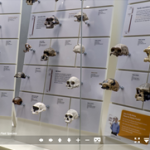By Professor Tiffany Banks On Tuesday, September 30th , students from my COMM 108: Foundations…
by Alejandra Morales Picard, Professor, Psychology

As I designed the assignments that would be the focus of my fellowship project, I was determined to create pedagogical experiences that varied in format and allowed students to use/develop different types of skills. After much consideration, I settled on three assignments that would be completed by students in my Human Growth and Development class (PSYC 203).
PSYC 203 students were asked to explore developmental effects of environmental change by: 1) taking a virtual tour and analyzing the Hall of Human Origins exhibit in the National Museum of Natural History 2) writing a case study of a community impacted by environmental change 3) working collaboratively to create a collection in the Smithsonian Learning Lab (SLL) that portrayed a story of environmental change and its effects.
Of the three assignments, I was most anxious about the last one. In addition to all of the usual challenges that students tend to encounter when working on group projects (e.g., coordinating collaborative work outside of class-time, inequities in contribution of labor, personality conflicts, etc.), they would also be working in a platform that they had little to no experience with. This was true for me as well. I had only recently learned about the SLL and was not yet fully comfortable using it. I worried about how user-friendly students would find the platform, whether it would work well as a virtual collaborative space, and whether there would be technological problems I wouldn’t know how to fix.
As I thought about how to introduce the assignment to the class, what instructions they would need, and what criteria I should include, I came to the realization that I needed to view the group project as pilot assignment and treat it as such. The truth was, I wasn’t entirely sure how well it would work, or what students would come up with. Because of this, I decided that flexibility and honesty would be key – I needed to give students room to be creative, providing them with the freedom to meet assignment objectives through various means (e.g., using articles, videos, art, podcasts, photos, etc.) and I needed to be candid about some of the “unknowns”.
I also concluded that I wanted (or needed) my students to play active roles in the development of assignment guidelines and in their project evaluations. Not only did I believe their feedback would be helpful, but I also wanted them to feel a real sense of ownership with regards to this assignment; that this was their project. I therefore invited students to complete a survey, which would give them the opportunity to share previous experiences with group work, express concerns that they had, and indicate how much of the grade should be based on the final product (representing the group) versus individual contribution. They were also given the opportunity to provide suggestions for effective collaboration.
I shared survey results with the class and used their feedback to develop a “best practices” sheet for effective collaboration and division of labor. While I knew this wouldn’t be a “silver bullet,” preventing any and all problems that may arise as students worked on their group projects, I hoped that it would provide guidance and be a clear indicator to students that their concerns were heard and understood.
In addition to the best practices sheet and the assignment requirements (i.e., what I wanted them to produce in the SLL), I also had to develop detailed guidelines for how to use the SLL platform to complete the group project. Providing sufficient information in a clear and concise manner proved to be a challenge. As I read all the instructions and requirements I developed, I realized that the project seemed complicated, more complicated than it really was.
To try to provide some clarity, I created a sample collection in the SLL that illustrated what a “story of environmental change” might look like. After going over all of this information with my students, I could sense apprehension. To reduce some of their anxieties, I shared some of mine. I let them know that this assignment was new to me as well, that I worried about whether I would be able to effectively communicate assignment objectives or resolve tech problems they may encounter. I thanked the class for their willingness to take this pedagogical journey with me and for serving as my “guinea pigs”. I think this helped.
As students worked together and created their group collections, tech problems arose. The SLL site was glitchy and we soon realized that it wasn’t meant for collaborative work (only one person was able to work in a collection at a time). Although they were a bit time consuming, we overcame these issues without too much difficulty. Students showed patience and persistence, and we found ways to work around the problems.
Despite my concerns, the group project assignment was generally a success. Students met assignment objectives well, and much of the feedback they provided in their project evaluations was positive. Many expressed an appreciation for the collaborative experience they had and for the opportunity to get to know classmates.
I learned that while new technologies or virtual platforms may introduce complications to groupwork, the issues that are likely to be most problematic are the oldest ones – group members that don’t pull their weight or are unresponsive to peers’ attempts to collaborate, and the challenges of coordinating group meetings outside of class-time. These were the concerns most commonly expressed by students prior to completing the group project, and they were the biggest obstacles they described in their post-project evaluations. I therefore ended the term asking myself the same question I’ve asked myself many times about group projects that require work outside of class – Do the potential benefits outweigh the stresses and challenges that some students will experience? I’m not sure.





This Post Has 0 Comments